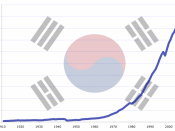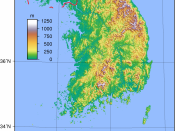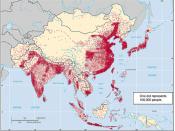The economy of the Republic of Korea (South Korea) has grown in the last 35 years. Per capita gross national product, only $100 in 1963, exceeded $20,000 USD in 2005. South Korea is now one of the world's largest economies (as of 2006, it is 14th in the world according to GDP measured in PPP, tenth when measured nominally).
The core of the South Korean economy has changed substantially over the country's six-decade existence. In the 1940s, the country was predominantly agricultural, with little industry. The emphasis shifted to light industry and consumer products in the following decades, and then to heavy industry in the 1970s and 1980s. As in other developed countries, the service sector has become increasingly dominant since the 1990s; it now comprises about two-thirds of the GDP.
South Korea has the tenth largest economy in the world (fourteenth largest by purchasing power parity), and the third largest in Asia, behind only Japan and China (fourth behind China, Japan, and India by purchasing power parity).
As one of the East Asian Tigers, it achieved rapid economic growth through exports of manufactured goods. This is in sharp contrast to the stagnation of North Korea's economy, which has turned for the worse since the disintegration of the Soviet Union. South Korea's per capita GDP is now roughly 12 times that of North Korea.
This phenomenal growth is often called the "Miracle on the Han River", the Han River being the main river that runs through the nation's capital and largest city, Seoul. In the 1980s and 1990s, growth continued as South Korea transformed itself from an exporter of mostly textiles and shoes into a major global producer of automobiles, electronics, shipbuilding, and steel and later, high-technology fields such as digital monitors, mobile phones, and semiconductors.
Administrative district centered around...


